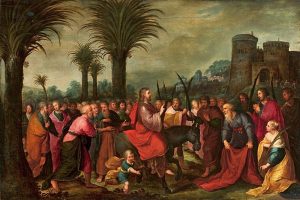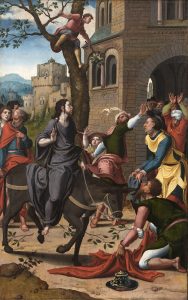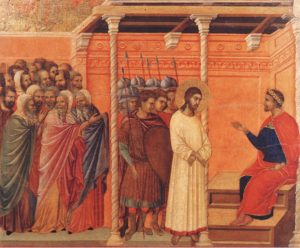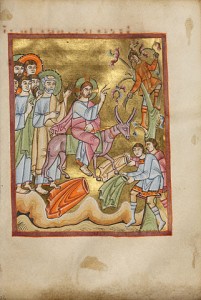Thoughts on Sunday’s Lessons for April 13, 2025 (Palm / Passion Sunday C)

Entry of Christ into Jerusalem (second quarter of 17th century), oil painting on oak wood from the workshop of Frans Francken the Younger (1581-1642). National Museum in Warsaw, Poland. (Click image to enlarge.)
The Liturgy of the Palms C
Gospel: Luke 19:28-40
Once celebrated in successive weeks, Palm Sunday and Passion Sunday now are joined on the Sunday that begins Holy Week. This combined liturgy prompts us to watch in shock and surprise as the crowds who cheered for Jesus upon his arrival in Jerusalem abruptly turn to mocking him and calling for his crucifixion. The Liturgy of the Palms begins as the people wave palm leaves in celebration as Jesus rides a colt into Jerusalem while the crowd chants the words of the prophet Zechariah celebrating the arrival of Israel’s king: “Rejoice greatly, O daughter Zion! Shout aloud, O daughter Jerusalem! Lo, your king comes to you; triumphant and victorious is he, humble and riding on a donkey, on a colt, the foal of a donkey!”
Psalm: Psalm 118:1-2, 19-29
This ancient hymn of celebration for victory resounds harmoniously with the Palm Sunday Gospel’s celebration of Jesus’s arrival in Jerusalem. The selected verses evoke a joyful crowd at the gates to the ancient Temple, clapping hands and loudly singing, praising the Lord our God, whose mercy and steadfast love endure forever. “On this day the Lord has acted; we will rejoice and be glad in it.”
The Liturgy of the Passion C
First Reading: Isaiah 50:4-9a
The waving palms and procession are complete, and the readings grow dark as the liturgy turns to the Passion. But even as shadows and twilight fall, the hope that rests in faith and trust remains. The Prophet Isaiah surely meant the “Suffering Servant” figure as a metaphor for Israel under the iron foot of exile, hoping someday to return home with God’s help. Christians must respect this tradition, but the Servant’s pain may make us think of Jesus too, particularly in its call to turn the other cheek against our enemies, knowing that God is with us.
Psalm: Psalm 31:9-16
The darkness grows still deeper in this portion of Psalm 21. Echoing the pain of the Suffering Servant, the Psalmist reminds us that numbing anguish can sap the strength of body, mind, and soul. Yet hope remains even in the darkest depths. Even when life seems full of pain and void of hope, we trust in God and pray: “Let your face shine upon your servant; save me in your steadfast love.”
Second Reading: Philippians 2:5-11
This letter written by Paul from prison in Rome seems to resonate with Isaiah’s Suffering Servant. In poetic verses that may have been taken from an early Christian hymn, Paul tells us that Jesus “emptied himself” as fully human, even a slave; he became one with us even in suffering. Jesus took on human frailty as he bore the gruesome pain of crucifixion. With this as our model, Paul declares, we all are called to serve God and our neighbor humbly and obediently, becoming “more” through being “less.”
Gospel: Luke 22:14-23:49
Now we hear Luke’s telling of the Passion story. In its more than 100 verses, we are taken from the Last Supper with Jesus and his friends, where he declares the bread and wine his body and blood, to his arrest and the terrible account of Jesus’s torture and gruesome death. At the end of these long and horrifying events, the disciples were left with Jesus’s words to them at the Last Supper: “The greatest among you must become like the youngest,” Jesus told them, “and the leader like one who serves.”



